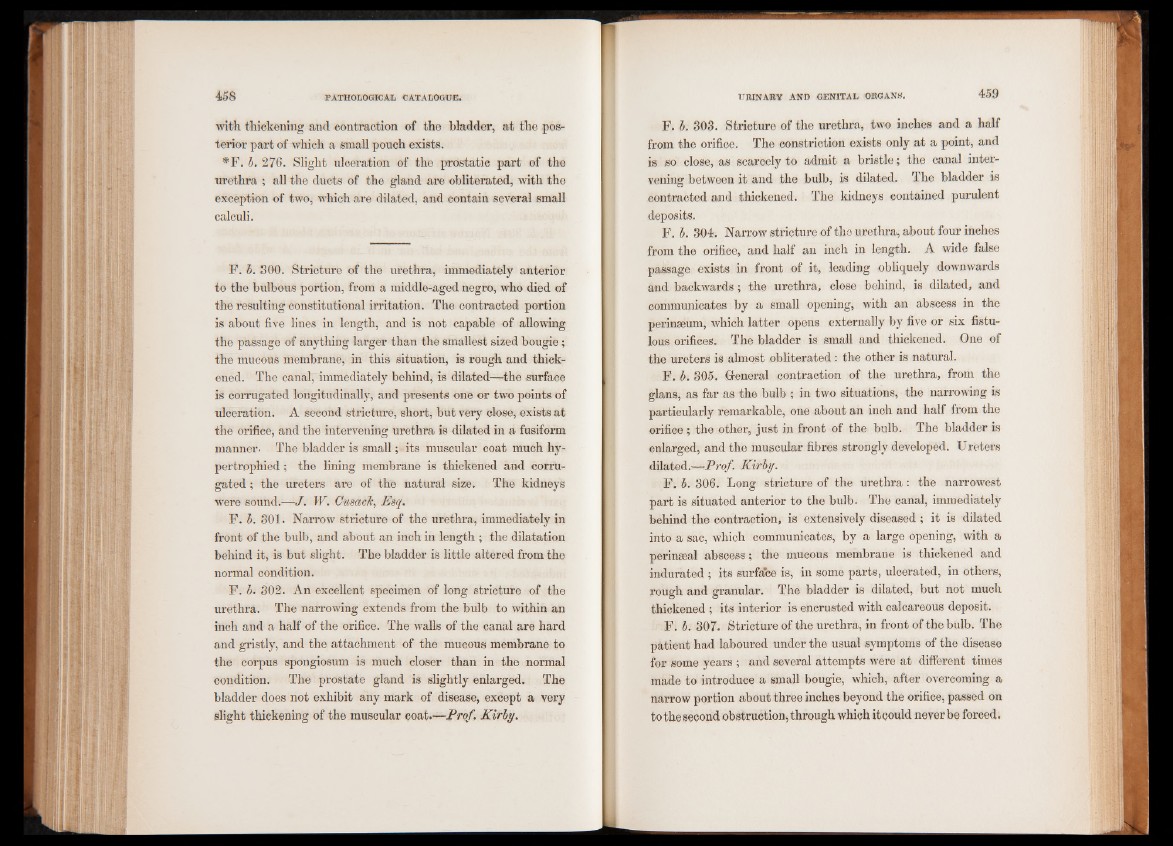
with thickening and contraction of the bladder, at the posterior
part of which a small pouch exists.
#F. b. 276. Slight ulceration of the prostatie part of the
urethra ; all the ducts of the gland are obliterated, with the
exception of two, which are dilated, and contain several small
calculi.
F. b. 800. Stricture of the urethra, immediately anterior
to the bulbous portion, from a middle-aged negro, who died of
the resulting constitutional irritation. The contracted portion
is about five lines in length, and is not capable of allowing
the passage of anything larger than the smallest sited bougie;
the mucous membrane, in this situation, is rough and thickened.
The canal, immediately behind, is dilated—the surface
is corrugated longitudinally, and presents one or two points of
ulceration. A second stricture, short, but very close, exists at
the orifiee, and the intervening urethra is dilated in a fusiform
manner. The bladder is small; its muscular coat much hypertrophied
; the lining membrane is thickened and corrugated
; the ureters are of the natural size. The kidneys
were sound.—J. W. Cusack, Esq.
F. b. 301. Narrow stricture of the urethra, immediately in
front of the bulb, and about an inch in length ; the dilatation
behind it, is but slight. The bladder is little altered from the
normal condition.
F. b. 302. An excellent specimen of long stricture of the
urethra. The narrowing extends from the bulb to within an
inch and a half of the orifice. The walls of the canal are hard
and gristly, and the attachment of the mucous membrane to
the corpus spongiosum is much closer than in the normal
condition. The prostate gland is slightly enlarged. The
bladder does not exhibit any mark of disease, except a very
slight thickening of the muscular coat.—Prof. Kirby.
F. b. 303. Stricture of the urethra, two inches and a half
from the orifice. The constriction exists only at a point, and
is so close, as scarcely to admit a bristle; the canal intervening
between it and the bulb, is dilated. The bladder is
contracted and thickened. The kidneys contained purulent
deposits.
F. b. 304. Narrow stricture of the urethra, about four inches
from the orifice, and half an inch in length. A wide false
passage exists in front of it, leading obliquely downwards
and backwards; the urethra, close behind, is dilated, and
communicates by a small opening, with an abscess in the
perinseum, which latter opens externally by five or six fistulous
orifices. The bladder is small and thickened. One of
the ureters is almost obliterated; the other is natural.
F. b. 305. General contraction of the urethra, from the
glans, as far as the bulb ; in two situations, the narrowing is
particularly remarkable, one about an inch and half from the
orifice; the other, just in front of the bulb. The bladder is
enlarged, and the muscular fibres strongly developed. Ureters
dilated.--Prof. Kirby.
F. b. 306. Long stricture of the urethra : the narrowest
part is situated anterior to the bulb. The canal, immediately
behind the contraction, is extensively diseased ; it is dilated
into a sac, which communicates, by a large opening, with a
perinseal abscess; the mucous membrane is thickened and
indurated ; its surfa'ce is, in some parts, ulcerated, in others,
rough and granular. The bladder is dilated, but not much
thickened ; its interior is encrusted with calcareous deposit.
F. b. 307. Stricture of the urethra, in front of the bulb. The
patient had laboured under the usual symptoms of the disease
for some years ; and several attempts were at different times
made to introduce a small bougie, which, after overcoming a
narrow portion about three inches beyond the orifice, passed on
to the second obstruction, through which itcould never be forced.